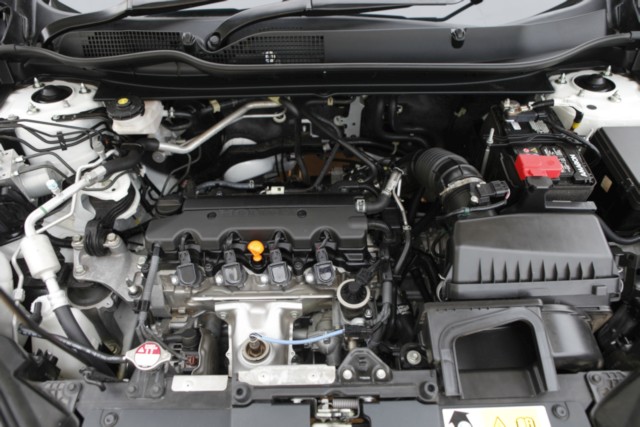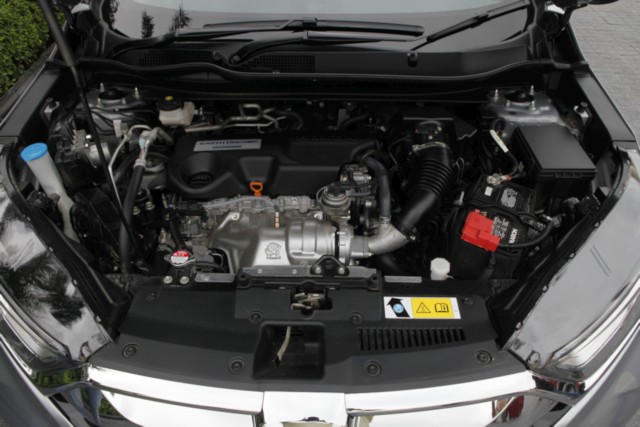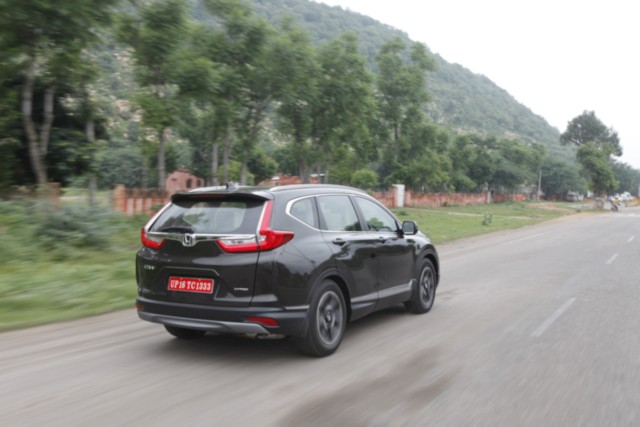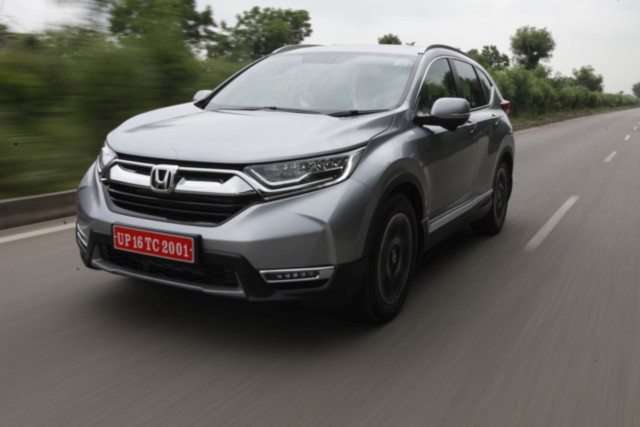Powertrain and Driving Dynamics

Bringing the new Honda CR-V its go is a choice of a familiar petrol engine or a new turbo-diesel unit. The 2.0-litre four-cylinder petrol makes 155 PS and 189 Nm. Unlike the previous model, it gets a steel-belted CVT automatic, or continuously variable transmission, that drives the front wheels. No, the petrol doesn’t get a four-wheel driveline. The diesel is the global four-cylinder 1.6-litre turbo-diesel from the Earth Dreams family. While we’d sampled the 160-PS twin-turbo 1.6 in Europe some time ago, this one, with its single turbo, makes 120 PS and 300 Nm. That seems just about adequate for a car of this size, provided you don’t have high-power expectations and prefer a docile motor.
We first went out in the petrol, heading up to Nahargarh fort. The 2.0-litre i-VTEC unit felt quick enough for the 1.5+ tonne CR-V. Paired to the CVT, its unhurried and refined, but, when pushed, can get quite noisy with the engine stepping into the upper reaches of the rev range. The ride quality was good for its urban all-rounder intentions, although road noise was audible. The pot-holed, semi-finished road conditions didn’t make things any better. That said, the steering feel was good, and turn-in was quick and effortless. Honda have also stuck with the strut front and multi-link rear suspension, making for a pliant ride that doesn’t give you much to complain about. Heading up to the fort meant a mix of tight bends and continuous ascents in elevation. The CR-V didn’t feel huge and ungainly and behaved well, reiterating its car-like handling, even with the added ride height. Listen closely, and the whine from the driveline catches your ears, especially when going up an incline at full steam. The proportions also make for an easy going car that doesn’t feel ungainly even on narrow streets half-filled with all sorts of animals. It makes for quick familiarization and reinforced its urban all-rounder credentials.

The i-DTEC diesel was the next one and this time we took to the open highway… or so we hoped. Even with the unruly traffic, the CR-V goes about its business smoothly. The diesel uses a nine-speed automatic gearbox and gets a choice of two- or four-wheel drive. We had the former, but we were informed that the latter has had its all-wheel-drive (AWD) system recalibrated to deliver more torque to the rear when needed. The drive is front-biased, but can be split by as much as 60:40 front to rear. The transmission is a shift-by-wire unit, using electronics rather than mechanical linkages. This has allowed Honda to use buttons and switches for Park, Reverse, Neutral and Drive functions. Honda also have a reverse camera to assist with that aforementioned Reverse function, but the resolution on the display should be way better considering the expected price point. The lane change assist uses a camera in the left wing-mirror to take care of blind spots and uses the same centre display; a useful bit of equipment.
On the road, the Honda CR-V diesel felt up to the task of getting to the legal speed limit by doing it fairly briskly. The clearance and bodywork design allowed it to deal with broken roads and sudden disappearance of tarmac only to be replaced by undulations of dirt all in its stride. Thankfully, standard ABS and assist systems are present in the form of stability control, hill-start assist and a driver alertness monitor. Honda also have what they call Agile Handle Assist which is essentially torque vectoring by braking, which enables tighter and more precise cornering. Although 300 Nm may seem like a lot, for a car the size and weight of the CR-V, it feels just about adequate and can get quite a bit of engine noise through to the cabin when pushed. It’s capabilities, though, are not compromised, and that’s important. Especially seeing as its positioning as an urban family car meant for everyday use.

That’s its strong point. If you’re not looking for enthralling performance, the CR-V can deliver with its thoughtful interior and flexibility. It’s a smart car that can do just about anything and has quite a brand name to lie back on, too. Reliability and Honda have always gone hand-in-hand, and that’s yet another important factor to consider. It was always around, the CR-V, and now it intends to make its presence felt. It will be launched this month and all that’s left is to hope that Honda get the pricing right and deliver to the urban space the competitive offering it needed.
Need to Know – Honda CR-V
i-VTEC (Petrol)
Price: Rs 26 lakh (estimated)
Engine: 1,997 cc, naturally-aspirated, in-line four, petrol
Max Power: 155 PS @ 6,500 rpm
Max Torque: 189 Nm @ 4,300 rpm
Transmission: Continuously variable, automatic, front-wheel drive
Weight: 1,545 kg
i-DTEC (Diesel)
Price: Rs 26-30 lakh (estimated)
Engine: 1,597 cc, in-line four, turbo-diesel
Max Power: 120 PS @ 4,000 rpm
Max Torque: 300 Nm @ 4,000 rpm
Transmission: Nine-speed, automatic, front-wheel drive/all-wheel drive
Weight: 1,666 kg/1,725 kg





















Leave a Reply